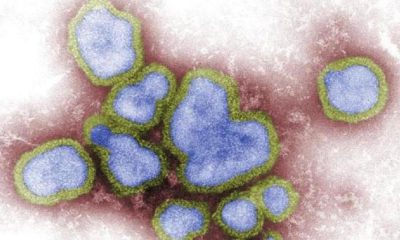World
Otter, sea lions and red foxes test positive for H5N1 bird flu

A marine otter and three sea lions in Chile have died of H5N1 avian influenza, and three foxes in France were also infected, officials reported on Tuesday as the number of affected mammals continued to rise.
The National Fisheries and Aquaculture Service said the otter was found dead along a river in Arica in northern Chile. It’s the first time a marine otter – which, unlike the sea otter, lives mostly on land – has tested positive for bird flu.
“This male specimen stranded dead in the vicinity of the Lluta River wetland near Las Machas beach along with birds in the same condition,” María Soledad Tapia Almonacid, of the aquaculture service, said in Tuesday’s update.
Last month, Chile reported that a sea lion in the country had tested positive for bird flu, which followed an outbreak in neighboring Peru which has killed nearly 3,500 sea lions so far. A second sea lion tested positive last week.
Tapia noted that the number of affected sea lions has now risen to three after another one was found in the Tarapacá region.
“The marine otter is an aquatic mustelid that inhabits the same rocky shores of Peru and Chile inhabited by sea lions,” Peruvian scientists said in a study published last week. “We have anecdotal knowledge that some otter carcasses have started to wash onto Peruvian and Chilean shores.”
The scientists added: “Fortunately, marine otters do not live in large groups, which might limit intraspecies contagion. However, direct mammal to mammal transmission has been suggested as a possible explanation for an outbreak in a Spanish mink farm [and] the massive South American sea lion die-off currently underway in Peru.”
Also on Tuesday, the World Organization for Animal Health reported that three red foxes were found dead in a nature reserve near Congis-sur-Thérouanne in France, northeast of Paris. A sample from one of the foxes – which were found near dead gulls – has since tested positive for H5N1.
The global spread of H5N1 avian influenza clade 2.3.4.4b – and the recent spread to a growing number of mammals – has raised concern about the possibility of a future variant which could lead to human-to-human transmission. So far, only a few cases have been found in humans after contact with infected birds.
“The global H5N1 situation is worrying given the wide spread of the virus in birds around the world and the increasing reports of cases in mammals, including in humans,” Dr. Sylvie Briand, a WHO official, said on February 24. “WHO takes the risk from this virus seriously and urges heightened vigilance from all countries.”
Last week, China reported a case of H5N1 bird flu in a 53-year-old woman from Jiangsu province. This news came only a week after an 11-year-old girl in Cambodia died from an older variant of the virus, which also infected her father.
In January, Ecuador reported the first human case of H5N1 bird flu in South America. The 9-year-old became seriously ill but has since recovered. A 38-year-old woman in China died in September.


-

 World6 days ago
World6 days agoEthiopian volcano erupts for first time in thousands of years
-

 Legal3 days ago
Legal3 days agoUtah Amber Alert: Jessika Francisco abducted by sex offender in Ogden
-

 Legal1 week ago
Legal1 week agoWoman in critical condition after being set on fire on Chicago train
-

 US News2 days ago
US News2 days agoExplosion destroys home in Oakland, Maine; at least 1 injured
-

 World1 week ago
World1 week agoHurricane Melissa registered 252 mph wind gust, breaking global record
-

 Health3 days ago
Health3 days agoMexico’s September human bird flu case confirmed as H5N2
-

 Legal1 week ago
Legal1 week agoSuspect in San Diego stabbing shot by authorities after fleeing into Mexico
-

 Legal1 week ago
Legal1 week ago1 dead, 2 injured in shooting at Dallas Walmart parking lot



